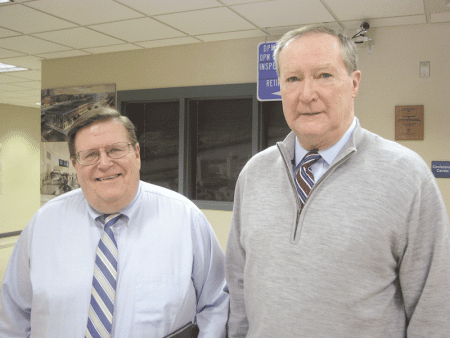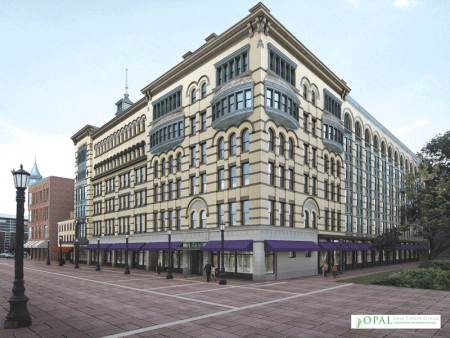
Developers Ramp Up Plans at Historic Court Square Building
A Changing Vision
 Long touted as the potential site of a boutique hotel, the historic building at 13-31 Elm St., bordering Springfield’s Court Square, is now the focus of a different vision, due to MGM Springfield’s own hotel plans. Peter Picknelly’s OPAL Real Estate Group now sees the property as a mixed-use center for retail, office space, and market-rate housing, and is working with the city to make the $40 million project a reality — and yet another key element to Springfield’s downtown revival.
Long touted as the potential site of a boutique hotel, the historic building at 13-31 Elm St., bordering Springfield’s Court Square, is now the focus of a different vision, due to MGM Springfield’s own hotel plans. Peter Picknelly’s OPAL Real Estate Group now sees the property as a mixed-use center for retail, office space, and market-rate housing, and is working with the city to make the $40 million project a reality — and yet another key element to Springfield’s downtown revival.
When Kevin Kennedy talks about the potential of the long-vacant building on Elm Street, across Court Square from City Hall, he doesn’t consider it in a vacuum, but as one more complementary piece in the evolving story of Springfield’s downtown.
“What’s important about downtown, if you look at a three- to five-year window, you should have a really vibrant, entertainment-centric complex with MGM Springfield, more market-rate housing, along with a first-class intermodal transportation complex at Union Station, and hopefully new east-west rail at some point. We’re really talking about a completely different dynamic downtown,” said Kennedy, the city’s chief development officer.
He was speaking specifically of how a planned rehabilitation of 13-31 Elm St. into a mixed-use center for retail, office space, and residential units will create added vibrancy in a central business district which will be anchored by Union Station to the north and MGM to the South.
“This is a key project in the city,” said Chris Moskal, executive director of the Springfield Redevelopment Authority (SRA), which owns the building. “When you look at Union Station and its reputation, and this building and its reputation, they’re amazing anchors to both sides. We’re moving forward, but we’ve got to put together a tremendous amount of financing in order to accomplish what will be a $40 million project.”
OPAL Real Estate Group, which has been the SRA’s preferred developer on the project since the summer of 2011, had originally wanted to convert the property to a boutique hotel, a project OPAL President Peter Picknelly’s father had advocated before his death in 2004.
But MGM Springfield changed its casino design four months ago, nixing a planned, 25-story hotel at 73 State St. and replacing it with a six-story hotel at Main and Howard streets — a location the casino operator had planned to develop market-rate housing, a requirement of its host-community agreement with Springfield.
So MGM was forced to look off site to develop market-rate housing, and has since been in talks with OPAL about some kind of partnership at the 13-31 Elm St. property. The plan that has emerged calls for retail space on the ground floor, office space on the second floor, and 56 units of market-rate housing on the top four floors.
“For the past four years, OPAL has done due diligence in terms of structural analysis and historical analysis of both buildings, and also a hazardous review based on age, asbestos, lead paint — all those issues have already been addressed professionally,” Moskal said. “They’ve looked at what kind of scenarios might work, not only financially but in terms of fitting into the downtown.”

Chris Moskal, left, and Kevin Kennedy say 13-31 Elm St. can be as much of an anchor for Springfield’s downtown as Union Station a few blocks north.
In his conversations with the SRA, Picknelly has said he wants to complement what’s already happening downtown,” Moskal relayed. “He sees the value of having the retail on the first floor; there was a unique mix there before — a snack bar, a barber shop, a jewelry shop on the corner. He feels those first two floors of retail and office space are an easy sell. And he also feels that 56 units of market-rate housing will have some charm and appeal for people.”
Those might include older people looking to downsize or young professionals drawn to the possibility of living in an entertainment center. The units will be rentals, not condos, because of requirements involved in using historic or new-market credits.
“We think they have some great ideas,” Moskal added, “and, again, it’s going to complement what we already have and not duplicate what’s across the street.”
Life and Work
As part of its mission, the SRA acquires buildings bedeviled by urban blight and sells them to developers looking to bring them back to life.
In 2009, Springfield took ownership of 13-31 Elm over delinquent taxes and called for requests for proposals, eventually awarding preferred-developer status to OPAL in July 2011. Since proposing the market-rate-housing piece, OPAL has partnered with Winn Development, one of the region’s leaders in housing development, to move the effort forward. That’s a positive, Moskal said, “given their history, not only with residential rehabilitation, but for using historic types of buildings in their projects.”
The property also includes the adjoining 3-7 Elm St., the oldest mercantile building in the city. The estimated $40 million development cost would include no new parking structure, just surface parking behind the buildings.
“They’ve been talking to MGM to contribute to the project,” Moskal said of OPAL. In addition, they have, over the past four years, already secured money in tax credits. They’ve qualified the property for $8 million in federal tax credits and already received $2.6 million in state historic tax credits. They are moving toward this year, applying for new-market tax credits, which, in a project of this magnitude and complexity, they feel they need. In addition, further down the line, [Picknelly] would like to talk to the city about tax-increment financing while under development.”
Click HERE to download a PDF listing of area commercial properties
Kennedy compares the effort to the city’s $88.5 million project to overhaul the long-dormant Union Station into an intermodal transportation center that will, hopefully, revitalize the area surrounding Springfield’s famous Arch. This multi-phase endeavor entails both new construction — especially a six-level parking garage and adjacent bus terminal — and historic renovation of both the station’s interior and exterior.
“In some ways, I compare [Elm Street] to Union Station in terms of the difficulty of rehabbing an old, historical building,” Kennedy said. “I would also compare it to the importance of Union Station in a sense, right in the city of Springfield’s town square and across the street from the $950 million MGM complex.”

This rendering shows OPAL’s vision for converting 13-31 Elm St. into a bustling, mixed-use complex.
However, it also comes with the same complexities Union Station has, he added. “It’s very difficult to do a rehab of that building that age, but you have to stay with it because it’s so important. With a mix of 35,000 square feet of commercial space, that’s really good for the downtown. It doesn’t dramatically affect the supply of commercial space downtown in terms of putting too much commercial space in. But it does finish a large swath of the central business district.”
City on the Rise
Kennedy said Picknelly believes the market-rate units will be an easy sell at this time in Springfield’s history.
“And we agree with him,” he went on. “We also recognize it will take a while to put all the tax credits together necessary for the project.”
When MGM announced last fall that a skyline-level hotel would no longer be part of its project, city officials were taken aback, and some residents felt like the company was scaling back its commitment to the city. But MGM Springfield President has since made an effective argument that bringing the hotel — with fewer stories but the same number of rooms — closer to the casino will be a net positive. Moving market-rate housing to 13-31 Elm may turn out to be another plus, Kennedy said.
“We would really like to position ourselves as an entertainment capital of Western Massachusetts at least, and also an innovation center for Western Massachusetts,” he said, positioning the city center as a destination where people will want to live and start businesses, and Court Square project fits into that vision. “Springfield’s host-community agreement with MGM also contains new policing strategy downtown, 15 new police officers, cruisers, surveillance cameras, new lighting downtown … we’re moving on all of this in a holistic, strategic way.
“The hard part,” Kennedy added, “is that all these fairly complex moving pieces have to work in relation with each other.”
If Union Station can come to life, Moskal added, there’s no reason why 13-31 Elm St. shouldn’t do the same.
“We started Union Station with $3 million, and have been begging, applying, doing anything we can get to where it is today, finally underway,” he told BusinessWest. “I see [Elm Street] as a private-sector Union Station project.”
In short, he concluded, “this is the right time for this project. Coming at the end of Union Station, we are thrilled with it.”
Joseph Bednar can be reached at [email protected]






